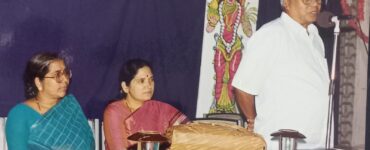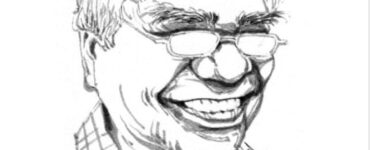Cities are home to people. It is people who make them. People living in the cities give a character to it, give it life. People also change the cities. Modern day nomads are people migrating from one city to another. Their movement, whether leaving or entering to make home, too changes the cities. But whereas the cities evolve and nomads wander, the rocks endure. The history of this world is the history of these cities, of the moving people and rooted rocks, carrying the stories of migration, identity, displacement, and the passage of time. This finely crafted collection of poems gives the readers glimpses of this world where the personal and the universal intersect, where the idea of belonging is both elusive and transformative.
Cities, Nomads and Rocks – a collection of seventy poems by Mitali Chakravarty is an intimate and expansive view of the world, which navigates the complexities of a nomadic human existence with sensitivity and a keen perception of broader historical forces. Here, cities, nomads, and rocks are not merely physical entities; they are symbols of movement, change, permanence, and resilience. They guide a reader through Chakravarty’s exploration of the human condition, from the bustling, ever-shifting landscape of urban life witnessed by the wandering existence of the nomad, to the enduring, unmoving nature of rocks that ground us in a world defined by flux.
Nomads just don’t witness but also carve cities; sites that sweep and swirl –
Plants are domicile, rooted but
humans are always on the go.
Nomads build cities that flow.
or get erased and die but still murmur to us –
Some lie under seas or
dust as they murmur
wisdom from eons. Or,
are these warnings?
Intricately tied to these physical entities, are also the notions of home and belonging, with migration and displacement as central concerns. The poems engage with the history of migration — both forced and voluntary — and the emotional and psychological toll that being a perpetual outsider can have on the individual.
In the city of Singapore, a man from Iran sells carpets –
weaving fears
and sorrows into his words
by the turrets of Sultan’s
Mosque…..
In another city, a restaurant sells Russian-Ukrainian dumplings while the man selling —
…….. continues to feed,
ladling tolerance, waiting for the war to end.
Within the confines of a country, some people move in desperation, seeking livelihood in cities far from their homes where —
They build tall
buildings, sleep
on pavements.
Coloured in dust,
where do they go
in the heat? Or,
when it rains on
the streets?
The nomadic figure, someone who is always moving because of one circumstance or another, carries a rich history of culture and remembrances, constantly transforming the lived experiences. In that sense there also seems to be a search for identity and belonging –
Rains bring remembrances
of a past wrapped in
nostalgia.
Hazy mists with whiffs
of madhabilata —
or the longing to hold onto the city of one’s past, the home –
I still hear melodies of
koels and dream of
jacarandas while
angsanas bloom.
and perhaps the sense of loss for what it once stood for –
…… Now, incarcerated,
history stands, mutilated
towards erasure. We wait
for the hangman’s noose —
For, we cannot write of Rajpath anymore.
The collection reminds us that migration is not just about physical movement but also about carrying of memories, cultural heritage, and encumbrance. The feeling of displacement is made even more poignant by the recognition that, for many, the sense of home may never fully materialize — no matter how far they travel or how much they adapt.
The third central motif — rocks — serves as a powerful symbol of resilience and permanence in the collection. In a world that seems increasingly defined by change and upheaval, rocks stand as a symbol of endurance. Chakravarty meditates on the unchanging nature of rocks, their ability to withstand the erosion of time, and their connection to the history —
Was history as bloody then,
before acid fields or purple-gold
skies rained destruction?
How are we to know —except
from the voices of these stones?
Rocks, in this sense, also become metaphors for the human spirit. Just as rocks are shaped by forces beyond their control — erosion, weather, time — so too are people shaped by their environments, histories, and experiences.
The Universe reverberates with a voice that fills
with the freedom of winds, the vastness of skies,
the tallness of mountains, the whisper of leaves
“We are all human and One.”
Chakravarty’s poetic voice is nuanced and layered, shifting between moments of lyrical beauty and stark, poignant clarity. There is an underlying melancholy here, a sense that the search for home and belonging is often a lost cause. Her tone can be contemplative, almost meditative, but also sharp when the need for emotional truth is called for.
……….. Each garden has
a new story to tell. Eve’s garden wept
over her abandonment. Again, a story
of lost innocence. My garden smiles
jasmine-scented, at the fabric
woven to veil women who bear
men and their own ilk, with mute
acceptance of myths.
Her voice also addresses the concerns of our rooted fellow beings, mute spectators to the atrocities committed by people —
The tree is but a traveller
that sees but cannot protest.
It remains like people —
mute in suffering. The
colour of love is also red.
But genocide is not love.
Can rain trees protest?
and the despair of being a helpless witness —
We all exist under the same
blue dome. Some wake up
to birdsong: some die in wars
Some of her poems are a cry for earth, for a planet devastated by climate crisis —
And yet they sing—sing of freedom
echoing in an atrophied dissolving Earth,
barren, floating like an asteroid rock
till life rebuilds from a primeval soup.
where one day its cities may crumble, and the earth may rebound and rebuild itself —
The end of ‘isms’ and ‘acies’
and crumbling cities.
Perhaps… the starting
point of a new species?
Interspersed in this collection, however, are also some limericks symbolizing the spirit of human endurance, its capacity to ricochet amidst the entire struggle —
Let us fall in love, you and me,
Under the haunted tamarind tree.
The resident ghost is buff
And makes it really tough
When we dance around in glee.
Cities, Nomads and Rocks is a powerful poetry collection that examines the complexities of migration, identity, and the search for belonging. Through her vivid imagery, shifting poetic forms, and rich metaphors, Mitali Chakravarty crafts a collection that speaks to the universal human experience of displacement while remaining deeply personal and reflective. The tension between movement and stasis, between change and permanence, runs throughout the collection, offering a nuanced exploration of what it means to be rooted in a world that is constantly in flux, while also inviting introspection, encouraging empathy, and reminding us of the resilience that resides within us all.
Title: Cities, Nomads and Rocks – Seventy Poems
Author: Mitali Chakravarty
Publication: Gibbon Moon, 2024
*









Add comment